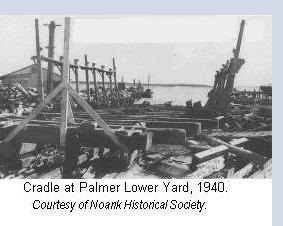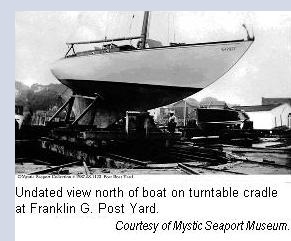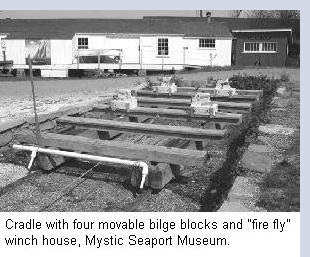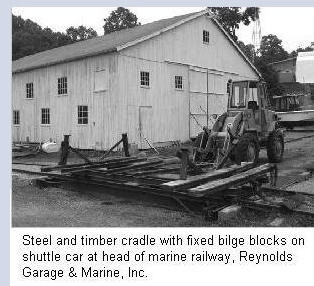Selected Reprints
The Marine Railways of Southeast Connecticut
by Michael S. Raber, with participation from
William N. Peterson, Former Senior Curator at Mystic Seaport Museum, and
Thomas C. Law, Vice President, Docko, Inc.
Marine railways were a critical component of Connecticut's maritime economy from ca. 1825-1970, providing cost-effective
repair facilities for all sizes of vessels. The state's under-documented, overlooked marine railways - all of
which were built on tidal waters - are a vanishing resource, with few in operation and many demolished. The great majority
of these facilities were in the southeast part of the state, especially between the Thames and Pawcatuck drainages.
To begin planning for possible protection of these resources and to enhance public education, Raber Associates
conducted a survey in this region between 2003 and 2006 to identify remaining marine railways and evaluate their historical
significance. By placing these resources in the context of the history of marine engineering, regional economy, and
local development, the survey was intended to enhance public sensitivity to historic waterfront resources along Long
Island Sound and its waterways, as well as to develop recommendations for possible resource protection measures including
creating State Archaeological Preserves and nominating properties to the National Register of Historic Places.
This article summarizes the historic context of marine railway history in the study area.
The survey, funded by the Connecticut Department of Environmental Protection's Office of Long Island Sound
Programs, addressed all marine railways built in Connecticut for commercial purposes between the lower Connecticut
River (from about Chester downstream) and the Rhode Island border. There have also been a number of very small
"family" marine railways built to handle private recreational vessels on private property. To work within funding limits
and minimize site access issues, this survey did not address the "family railways." At various times, the study region
probably had at least two-thirds of all commercial marine railways built in the state, many of which were known in at
least summary fashion to members of the team assembled for this study. There is less information compiled on other
Connecticut marine railways, which have included sites in New Haven, Milford, Bridgeport, Norwalk, Greenwich, and
Portland. Focusing the study on the southeast part of the state increased the research value of limited grant funds.
Companion or continuing studies of Connecticut's other marine railways, which may require relatively limited initial
research, can be prepared in the future.
Prior to the advent of travel lifts in the 1960s, there were several ways to move a vessel from a floating position
to a dry one for bottom repairs or storage. The most ancient involved floating or hauling a vessel onto a beach and
careening or heaving it on its side, a laborious operation which required reversing the process to re-float the vessel.
In different forms, drydocks allowing for repairs of upright vessels supported by keel and bilge blocks appeared as early
as the 3rd century B.C. in Egypt, and became common in England by the late 15th century. Steam powered pumps
made drydocks more common by the late 18th century, but in their stationary or excavated form they represented a very
large investment. By the early 18th century, floating drydocks first appeared in England and Russia as converted
ships' hulls designed to receive floating vessels and lift them for repairs. A century later, special-purpose floating
drydock structures consisting of flat-bottomed pontoons with high side walls were being patented; the earliest American
patent is dated at ca. 1816. Water-tight compartments in the side walls, filled or emptied by steam pumps, served to lower
or raise the structure. A sectional floating drydock was first patented in the United States in 1837.
A marine railway consists of an incline - typically with timber foundations - extending from a point on shore
above high tide to a point offshore well below low tide, parallel sets of metal rails on the incline supporting a
roller-borne cradle or carriage on which a vessel can be supported with blocks, levers, or shores (braces), and a
mechanical system for moving the carriage up and down the incline. Marine railways had many advantages over drydocks,
providing drier, better-lit, and better-ventilated working surfaces at approximately the same elevation as the adjacent
shipyard or boatyard. Compared to stationary drydocks, marine railways were much less costly to build, used less
fuel than drydock pumps, were faster to operate, and did not require a particularly wide tidal range to float a vessel in
or out of the dock. Floating drydocks were likely more expensive to build than larger marine railways, and required
waters which were both relatively calm and wide enough not to interfere with navigation channels.
In Connecticut's southeast coastal region, tidal range is generally about 2.5-4 feet, and many of the waterways are
narrow and exposed to unsettled weather conditions. These conditions may explain why the vessel construction
and repair industry in this region, particularly in the lower Thames and Mystic rivers, made extensive use of marine
railways beginning in the 1820s, including what were probably some of the earliest such mechanisms used in the
United States. Marine railways have most typically been used for repair and, in the 20th century, vessel storage, but
at some small sites with limited waterfront there are also examples of boat or ship construction on marine railway cradles.
For approximately a century following their appearance in southeast Connecticut - until the end of large wood
vessel construction ca. 1920 - the use and geographic distribution of marine railways were closely related to regional
patterns in maritime commercial history. From the mid-17th century English settlement of the lower Connecticut
River Valley and the coastal areas to the east until the early 19th century, the economies of the river and coastal towns
were focused on fishing, oystering, shipbuilding, and active participation in the West Indies trade. Shipyards serving
these activities were concentrated on the Connecticut River below Middletown, in New London and Norwich on the
Thames River, and at Noank near the mouth of the Mystic River. The West Indies trade was diminished and largely
eliminated by international politics, war, embargo, and depression ca. 1807-1815, but shipbuilding in the study area
was sustained through the mid-1860s by expanded fishing, whaling, coastal traffic, and vessel demands of the New
York City-based cotton trade.
Some Connecticut River ports with shallow water depths could not compete with demands for larger vessels,
but ship construction at New London, Essex and Mystic area yards flourished through the Civil War. Vessel repair,
including some use of marine railways, gradually became an integral part of larger shipyard operations. Until ca. 1860,
all but two of the marine railways built in the study area - a total of about thirteen - were found in New London, a center
of whaling; short-lived facilities operated in Deep River ca. 1834-35 and Essex ca. 1855-81. Just before the Civil War,
during which wooden shipbuilding peaked in Mystic, brothers John (1818-1876) and Robert (1825-1913) Palmer installed
three marine railways at two of their three Noank yards, the first such facilities on the Mystic River. Thomas
Wetmore also built a marine railway in Norwich ca. 1860.
After the Civil War, new ship construction in most parts of southeast Connecticut declined sharply until the
early 20th century. Regional factors included the drop in whaling traffic and a lack of yards capable of building large
iron vessels. High costs of labor and insurance, compared to British and Canadian yards, were also major problems
confronting most American shipbuilders. During this period, many shipbuilders and marine contractors in the study
region adapted by concentrating on ship repairs and outfitting, taking advantage of lower labor costs and a central
location relative to New York or Boston. Approximately eighteen marine railways were built in the region ca. 1865-1900,
though many operated for only short periods. By far the largest marine railway from this period was the 658-footlong
one built in 1879 by the Palmer brothers at the southernmost (lower) of their three yards in Noank, with a 265-foot-long
cradle hauled with a 75-hp steam engine. This was one of the largest marine railways ever built in the United
States, and allowed the firm to work on the biggest craft operating between New York and Boston.

The Palmers also diversified their business by specializing in construction of wooden carfloats, designed to tow
loaded freight cars across the Port of New York between rail terminals. While carfloat construction did not require marine
railways, the installation of boilers and engines in steamboats and other coastal vessels included regular use of such
facilities. On Shaws Neck in New London, the Morgan Iron Works and its successor the New London Marine Iron
Works used three older steam powered marine railways ca. 1889-1891 to do this kind of work, replacing them with a
larger one in 1894.
One small but increasingly bright spot amidst the diminished regional construction of large wooden vessels in
the late 19th century was the advent of schooners built to haul coal for steam powered manufacturing, a demand
which became more important for ship construction and repair work in the study region during the early 20th century.
Demand for coal in New England's industrial ports, not readily accessible by rail from mid-Atlantic coal fields,
stimulated marine shipping from coal terminals between Norfolk and New York by the 1870s. Towing of coal in
canal-size barges sufficed in relatively sheltered coastal waters, but these could not handle the rigors of ocean travel
beyond Narragansett Bay. Large multi-masted schooners, built mostly in Maine, dominated the long-distance coal
trade until the late 1880s. Six were built in New London in the early 1890s, including several at the Crocker, Davidson,
& Co. or Herbert J. Crocker yard on Shaws Neck, which at the time was equipped with four marine railways.
Beginning in the late 1880s, several types of schooner barges began to replace multi-masted schooners. A schooner
barge was a towed cargo ship, usually with two to four short masts rigged fore-and-aft for steadying in heavy seas,
towed by a large tugboat. One tug could tow four to six schooner barges, each of which required a crew of three to
four men. Despite dangerous seagoing towing conditions, the economy of this shipping mode, compared with more
traditional individual sailing ships, quickly ended most new schooner construction until World War I. Older ships were
converted to schooner barges ca. 1890-1925 by eliminating top masts, removing bowsprits and jibbooms, and adding
nearly-continuous main deck hatches, large towing bitts, and small steam engines for sail hoisting. Over 100 new schooner
barges were also built ca. 1890-1900, with distinctive hull features. Most as-built or converted schooner barges were
wooden; a few were steel.
The coal trade increased the construction of these craft and large tugboats in New London and Mystic during the
first two decades of the 20th century, until the advent of steam-powered colliers and the demise of New England's
textile industry in the 1920s sharply reduced demand for schooners or schooner barges. Coal trade vessel repairs,
and the brief windfall of military work generated during World War I, led to the most prominent new marine railways
in the region in this period. Approximately ten marine railways were constructed for commercial purposes ca.
1900-1920 in New London, Groton, Noank, and Essex, with the largest being one rebuilt by the New London Marine
Iron Works, the three built by the Thames Tow Boat Company in New London, and one built for the Electric
Boat Company in Groton by Crandall Engineering Company. The latter four marine railways were the only examples
in the region of what were sometimes called railway drydocks, developed by Crandall, which were distinguished
by large cradles with horizontal bottoms as opposed to bottoms parallel with the incline of the tracks.
The Thames Tow Boat Company, associated with the coal retailing firm of F. H. Chappell & Company, began
operations in Norwich in 1865, and by the early 1880s became one of the earliest to engage in long-distance towing
of schooners or schooner barges. Beginning in 1901, Thames Tow Boat constructed a large yard in northern
New London for construction and repair of wooden ships and barges, including its own sea-going tugboats, with two
steam powered railway drydocks. The proximity of this yard to that of Electric Boat, which opened its Groton facility
in 1911 for submarine and other ship mechanical equipment, provided Thames Tow Boat with considerable
World War I work in submarine repairs after Electric Boat began to build submarines for the U.S. Navy. Electric Boat
built its railway drydock - among the first electric-powered marine railways in the region - yachts
ca.1915. Wartime shipping
demands also sustained some of the older yards using marine railways, such as the lower Palmer yard used by Pendleton
Brothers and the Groton Iron Works.
Shortly after the war, demand for new wooden ships declined permanently, and Thames Tow Boat shifted to an
emphasis on yacht repairs, adding a third, electric-powered railway drydock to its yard in 1919 (Gratiot 1983). Beginning
in the second decade of the 20th century, and accelerating after 1920, the introduction of marine diesel engines led
to improved, widely-available designs for yachts, lobster boats, and other recreational and fishing craft including
boats used to transport liquor during the era of Prohibition. Repair and storage of such craft at smaller yards appears to
account for more than half of the marine railways built in the region ca. 1900-1920, and became the principal reason
for construction and use of these facilities into the 1970s.

Until the 1930s, marine railway use remained associated primarily with yards which also built boats, yachts or - less
frequently after World War I - ships. The oldest extant - though heavily rebuilt - marine railways, in the Noank section
of Groton, were built by small shipyard operators ca. 1900-1910, as were several other contemporary but demolished
marine railways at new or late-19th-century yards in Essex. The only marine railway in the survey region known to
have been built in the 1920s, a recently-demolished one at the Franklin G. Post yard in Mystic, was part of a business
prominent for its design and construction of wooden, gas-powered pleasure and commercial boats. The last operators
of the lower Palmer yard, the Noank Shipyard, added three poorly-documented, now-demolished marine railways for
yacht maintenance in the late 1920s or early 1930s, by which time little if any new construction was done at this large
facility. During the early 1930s, several other yards specializing in wooden boat construction opened with marine railways,
notably at the Persson and Brockway sites in Old Saybrook. At the end of this decade the Post yard - by then operating as
Franklin G. Post & Son - greatly expanded its facility including the construction of a regionally-unique
marine railway with a turntable allowing boat transfer to any one of five nearby sheds.
The Post, Persson and Brockway yards were among the last in the survey region to build wooden boats, and appear
to have been the last yards of this type to install marine railways. Marine railway use began to shift dramatically
in the 1930s, towards commercial and private facilities devoted only to boat storage and repair. Of the approximately
twenty-six marine railways known to have been built in the survey region after 1930, all but the three noted
above appear to have been built at such facilities, many of which were relatively small. The principal factors in this
shift were a decline in boat construction during the Great Depression, and the relative ease with which experienced
yard operators and mechanics could build small marine railways with automobile engines and rails salvaged from the
region's disappearing trolley systems.


Virtually every extant example of a marine railway in the survey region, whether operating or moribund, appears
to have rails from this source, suggesting an unintended consequence of the decline of trolley lines beginning in the
1930s. In some cases, such as the Silveira marine railway in Keeney Cove on the Niantic River, tugboat and lobster
boat operators built or acquired marine railways principally for maintenance of their own vessels. More frequently, marine
railways were the most prominent features at the increasing number of marinas, which had smaller footprints
and facilities than the larger yards once used to build as well as repair or store vessels. Among the earliest of the
surviving marina marine railways, and the most unusual operating one in the survey region, is the hauling facility built
at Reynolds Garage & Marine, Inc., in 1932 on Hamburg Cove in Lyme, which features ten tracks used for tractor-hauled
movement of boats on cradles from the marine railway to the marina's sheds.
World War II brought increased repair and construction work to the region, and led to greater use and occasional
expansion of individual marine railways, but apparently not to any construction of new marine railways.
Thames Shipyard, Inc., the successor to Thames Tow Boat Company, repaired submarines and converted merchant
ships for wartime purposes. Some of the seventy-four submarines built by Electric Boat were probably built using that
yard's railway drydock. Essex Boat Works lengthened one of its marine railways in 1943 to repair naval vessels, and
Franklin G. Post & Son built naval patrol and air rescue boats.
The immediate post-war era saw increases in recreational boat ownership and demands for marina services, with
the introduction of non-traditional materials such as plywood, glue, and fiberglass. By the early 1950s, the use of
boat trailers and privately-owned Jeeps made it possible for many boat owners to minimize or avoid the need to use
marina-based marine railways, but maintenance of larger vessels appears to have increased demand for such facilities into
the early 1960s. At least twenty marine railways were built in the survey region ca. 1945-1965, at the height of their use
by marinas, with all but a still operable one at Mystic Seaport for commercial/private use. It was probably in this period
that marine railways were most visible in the public eye, in part because marinas were more accessible to visitors than
shipyards.
Some of the factors increasing post-war marine railway use at marinas also contributed to the decline of these
devices. Recreational boats that were lighter, and often smaller, than wooden yachts and sloops could be lifted from
the water with construction cranes and double slings. The cranes could move boats away from the water for storage
faster and far more easily than was the case at most marine railways. By the early 1960s, this concept had evolved into
the travel lift, a rubber-tired gantry crane which sling-lifted boats from parallel finger piers and moved the boats around
the boatyard. Within about a decade, the travel lift had replaced marine railway use in most places within the study
region, leading to conversion of some sites to travel lift use and abandonment of other yards.
Insurance premiums and increasing labor costs also favored travel lifts, as did environmental regulations making
retention of oil-soaked marine lift gas engines more difficult. Early travel lifts' disadvantages, including limits on
liftable boat sizes and the potential to strain wooden yacht hulls, partly explain the retention of marine railways at a
few sites in southeast Connecticut. For owners of small boatyard sites with functional marine railways serving their own
vessels, there was also limited incentive to invest in the new technology. Of the five functioning marine railways in the
study region as of 2006, discussed below, three are in this latter category. The other two operable sites are at Mystic
Seaport, and at Reynolds Garage & Marine, Inc., a marina whose multi-directional boat handling matches that of many yards
equipped with travel lifts.
Funding provided by the Long Island Sound Fund administered
by the Connecticut Department of Environmental
Protection (DEP), through the sale of Long Island license
plates and contributions.